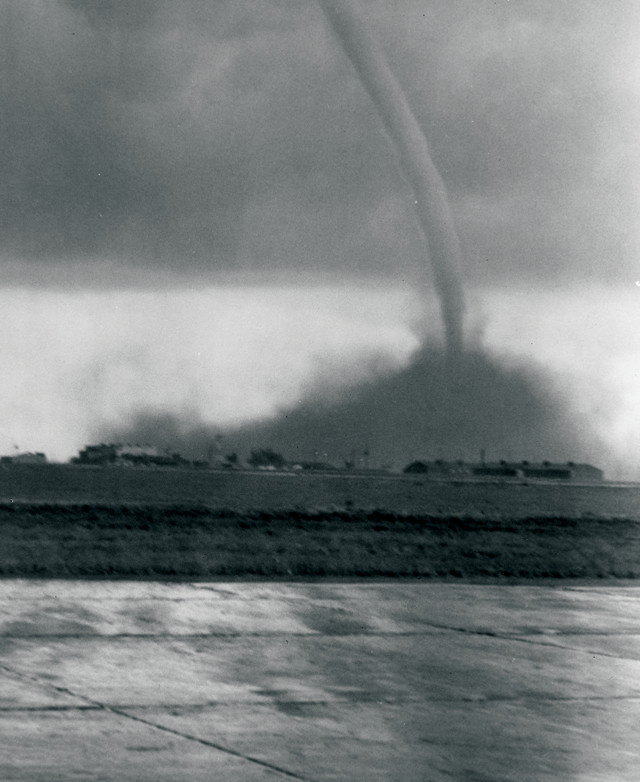
by Mary Caperton Morton Tuesday, April 18, 2017

A tornado passes near the Scottsbluff, Neb., airport on June 27, 1955. Credit: National Archives and Records Administration.
The inside of a strong tornado is an intense place, with wind speeds of more than 450 kilometers per hour and dramatic drops in air pressure and temperature. But due to the dangerous unpredictability of such storms, few real-time measurements have been taken inside actual twisters. In a new study, researchers took a mathematical approach to circumvent the danger and calculate temperature changes inside tornadoes, offering a glimpse into how these violent storms operate.
“Monitoring the interior conditions of tornadoes is very difficult and dangerous. Researchers have been killed trying, and conditions are so extreme that instruments are often damaged,” says Georgios Vatistas, an engineer at Concordia University in Montreal and lead author of the new study, published in the Journal of Aircraft.
So instead of relying on instrumentation to study the falling temperatures known to occur in tornadoes of all sizes, Vatistas and his colleagues used mathematical models. “Our intent was to look at the fundamental principles of intense vortexes and transfer the physical manifestations to mathematical equations,” Vatistas says. They approached it as a fluid mechanics problem, factoring in the conservation of mass and momentum and the ideal gas law to arrive at equations that describe the pressure, temperature and density of the violently revolving funnels.
Then, they tested the outputs of their equations to see if they matched the eyewitness observations made by three radio broadcasters who survived the funnel of a violent tornado in Scottsbluff, Neb., in 1955 by taking shelter in the basement of a stone building. All three reported frigid temperatures and difficulty breathing as the funnel, later rated as an EF4 on the Enhanced Fujita Scale, passed overhead. Vatistas and his colleagues calculated that temperatures inside the Scottsbluff funnel dropped from an ambient temperature of 27 degrees Celsius to a chilly 12 degrees Celsius. Furthermore, they found that the air density dropped to levels similar to those found in the “death zone” on mountains at elevations above 8,000 meters, explaining why the broadcasters had trouble breathing, Vatistas says.
Temperature drops in tornadoes have been known about for decades, but few studies have focused on elucidating this effect, says David Lewellen, an engineer at West Virginia University who was not involved in the new study. Mathematical models like those developed by Vatistas and colleagues can fill in data gaps for violent storms, he says.
“Tornadoes come in all different shapes, sizes and strengths. Even if you get excellent measurements from one tornado, it won’t tell you the whole story for all tornadoes,” Lewellen says. The new equations may help scientists better understand the range of variation from one storm to the next, he says. “Mathematical models can help us figure out what’s going on [across a range of storms].”
The work, however, is not likely to aid directly in predicting or tracking storms, he says. “The state of model simulations is pretty good these days. There’s a lot we understand fairly well, but other things we still don’t.” The most difficult challenges are to connect storm behaviors on different scales, under different conditions, and to predict which storm systems will generate tornadoes, he says.
The equations also have direct applications to engineering, Vatistas says, particularly in regard to refrigeration vortex tubes, which are used to cool cutting tools during machining, and with various electronic components. It also explains some of the temperature effects of the vortexes produced by airplane wings and helicopter blades.
© 2008-2021. All rights reserved. Any copying, redistribution or retransmission of any of the contents of this service without the expressed written permission of the American Geosciences Institute is expressly prohibited. Click here for all copyright requests.